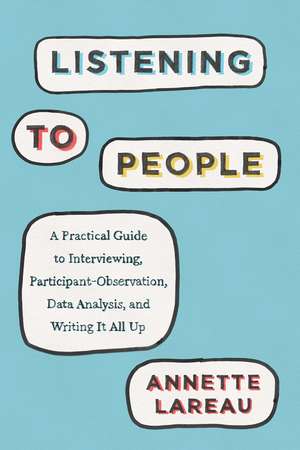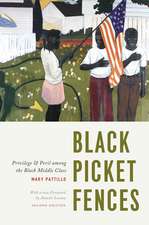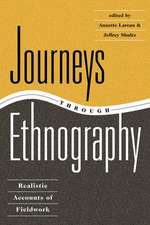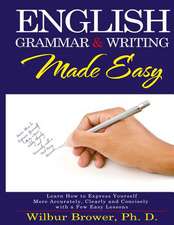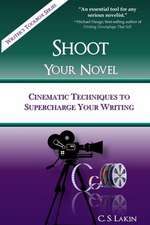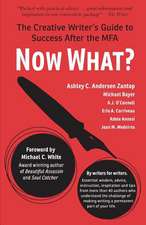Listening to People: A Practical Guide to Interviewing, Participant Observation, Data Analysis, and Writing It All Up: Chicago Guides to Writing, Editing, and Publishing
Autor Annette Lareauen Limba Engleză Paperback – 15 oct 2021
- Understand the importance of talking to others, including listening to feedback from others while conducting research
- Recognize that there is not only one right way to sculpt your study
- Learn how to plan the early stages of a project such as designing the study and choosing whom to study
- See how to navigate the IRB and how to perform practical matters while collecting data
- Learn how to plan before an interview and how to construct an interview guide
- Read real-life interviews with notes showing what probes work well and which are less successful
A down-to-earth, practical guide for interview and participant observation and analysis.
In-depth interviews and close observation are essential to the work of social scientists, but inserting one’s researcher-self into the lives of others can be daunting, especially early on. Esteemed sociologist Annette Lareau is here to help. Lareau’s clear, insightful, and personal guide is not your average methods text. It promises to reduce researcher anxiety while illuminating the best methods for first-rate research practice.
As the title of this book suggests, Lareau considers listening to be the core element of interviewing and observation. A researcher must listen to people as she collects data, listen to feedback as she describes what she is learning, listen to the findings of others as they delve into the existing literature on topics, and listen to herself in order to sift and prioritize some aspects of the study over others. By listening in these different ways, researchers will discover connections, reconsider assumptions, catch mistakes, develop and assess new ideas, weigh priorities, ponder new directions, and undertake numerous adjustments—all of which will make their contributions clearer and more valuable.
Accessibly written and full of practical, easy-to-follow guidance, this book will help both novice and experienced researchers to do their very best work. Qualitative research is an inherently uncertain project, but with Lareau’s help, you can alleviate anxiety and focus on success.
| Toate formatele și edițiile | Preț | Express |
|---|---|---|
| Paperback (1) | 172.17 lei 3-5 săpt. | |
| University of Chicago Press – 15 oct 2021 | 172.17 lei 3-5 săpt. | |
| Hardback (1) | 607.79 lei 6-8 săpt. | |
| University of Chicago Press – 14 oct 2021 | 607.79 lei 6-8 săpt. |
Din seria Chicago Guides to Writing, Editing, and Publishing
-
 Preț: 97.74 lei
Preț: 97.74 lei -
 Preț: 192.95 lei
Preț: 192.95 lei -
 Preț: 151.16 lei
Preț: 151.16 lei -
 Preț: 133.22 lei
Preț: 133.22 lei -
 Preț: 139.84 lei
Preț: 139.84 lei -
 Preț: 96.52 lei
Preț: 96.52 lei -
 Preț: 106.52 lei
Preț: 106.52 lei -
 Preț: 210.01 lei
Preț: 210.01 lei -
 Preț: 194.53 lei
Preț: 194.53 lei -
 Preț: 99.60 lei
Preț: 99.60 lei -
 Preț: 162.48 lei
Preț: 162.48 lei -
 Preț: 147.26 lei
Preț: 147.26 lei -
 Preț: 124.16 lei
Preț: 124.16 lei -
 Preț: 122.50 lei
Preț: 122.50 lei -
 Preț: 108.27 lei
Preț: 108.27 lei -
 Preț: 145.32 lei
Preț: 145.32 lei -
 Preț: 133.32 lei
Preț: 133.32 lei -
 Preț: 132.51 lei
Preț: 132.51 lei -
 Preț: 149.63 lei
Preț: 149.63 lei -
 Preț: 103.49 lei
Preț: 103.49 lei -
 Preț: 100.41 lei
Preț: 100.41 lei -
 Preț: 99.83 lei
Preț: 99.83 lei -
 Preț: 305.98 lei
Preț: 305.98 lei -
 Preț: 147.49 lei
Preț: 147.49 lei -
 Preț: 407.91 lei
Preț: 407.91 lei -
 Preț: 107.54 lei
Preț: 107.54 lei -
 Preț: 120.87 lei
Preț: 120.87 lei -
 Preț: 157.15 lei
Preț: 157.15 lei -
 Preț: 114.49 lei
Preț: 114.49 lei -
 Preț: 140.45 lei
Preț: 140.45 lei -
 Preț: 186.13 lei
Preț: 186.13 lei -
 Preț: 433.53 lei
Preț: 433.53 lei -
 Preț: 115.68 lei
Preț: 115.68 lei -
 Preț: 147.40 lei
Preț: 147.40 lei -
 Preț: 158.19 lei
Preț: 158.19 lei -
 Preț: 91.96 lei
Preț: 91.96 lei - 23%
 Preț: 576.92 lei
Preț: 576.92 lei -
 Preț: 187.79 lei
Preț: 187.79 lei -
 Preț: 235.83 lei
Preț: 235.83 lei -
 Preț: 237.81 lei
Preț: 237.81 lei -
 Preț: 148.29 lei
Preț: 148.29 lei -
 Preț: 143.00 lei
Preț: 143.00 lei -
 Preț: 172.90 lei
Preț: 172.90 lei
Preț: 172.17 lei
Nou
Puncte Express: 258
Preț estimativ în valută:
32.96€ • 35.81$ • 27.70£
32.96€ • 35.81$ • 27.70£
Carte disponibilă
Livrare economică 31 martie-14 aprilie
Preluare comenzi: 021 569.72.76
Specificații
ISBN-13: 9780226806433
ISBN-10: 022680643X
Pagini: 304
Ilustrații: 7 tables
Dimensiuni: 152 x 229 x 28 mm
Greutate: 0.46 kg
Editura: University of Chicago Press
Colecția University of Chicago Press
Seria Chicago Guides to Writing, Editing, and Publishing
ISBN-10: 022680643X
Pagini: 304
Ilustrații: 7 tables
Dimensiuni: 152 x 229 x 28 mm
Greutate: 0.46 kg
Editura: University of Chicago Press
Colecția University of Chicago Press
Seria Chicago Guides to Writing, Editing, and Publishing
Notă biografică
Annette Lareau is the Edmund J. and Louise W. Kahn Endowed Term Professor in the Social Sciences at the University of Pennsylvania. She is the author of a number of award-winning works including Unequal Childhoods and Home Advantage. She is the past president of the American Sociological Association.
Extras
Interviews and participant observation studies deepen our knowledge of people, institutions, and social processes. These approaches draw us into the meaning of events in the everyday lives of individuals, showing how people are affected by social structural forces. Well-crafted studies can make us feel as if we are close to the social events being vividly described. For example, while surveys of victims document the size and scope of disasters, in-depth interviews and participant observation can help us grasp unexpected ramifications...
Many people want to learn how to do high-quality in-depth interviews and participant observation. In my case, when I was beginning to learn how to do this kind of research, the literature I read left me feeling stumped. I could not find the advice I needed. The books seemed overly prescriptive. They informed me that I should sensitively “probe” in interviews, but they didn’t describe what that looked like, nor did they seem to recognize sufficiently the difficulties inherent in probing. As I read methodological appendices, I was especially frustrated when researchers who had carried out a participant observation study described gaining entry into a field setting as the result of a serendipitous event. How was I supposed to replicate such serendipity as I sought to break into a setting? Books about interviews and observation made it seem like doing a study would be relatively smooth sailing, but in my experience, it was not. I yearned to read a book that was more realistic and practical...
These challenges—that methods books are not practical enough and that potentially wonderful studies can flounder—led me to write this book. In Listening to People, I give concrete, practical advice for actually doing a wide variety of studies including class projects, theses, articles, and books... As the title of this book suggests, I consider listening to be the core of in-depth interviewing and participant observation. You must listen to people as you collect data, listen to feedback from others as you describe what you are learning during data collection, “listen” to the findings of others as you delve into the existing literature on topics that interest you, and “listen” to yourself as you sort through and prioritize some aspects of your study over others. As you engage in listening in these different ways, you will discover connections, reconsider assumptions, catch mistakes, develop and assess new ideas, weigh priorities, ponder new directions, and undertake numerous adjustments, all of which ultimately will make your contribution clearer and more valuable.
In analog photography, the film is developed, and prints are made in a darkroom. There, you use a machine to enlarge and then briefly expose the image onto white photographic paper, and subsequently you immerse the paper in a chemical bath. At first, the paper is completely blank. But then your photograph begins to take shape—very gradually and unevenly. It may even be hard to recognize the image when it is beginning to emerge, but very slowly the picture comes to life. If the image is too light or too dark, you return to the machine and change the amount of time you “burn” (give the image more light) or “dodge” (withhold light on part of the picture) to create a balanced photograph. Then, you put the new paper into the chemical bath, watch for the image to emerge, and finally plunge it into a “stop bath” when you are satisfied with the picture.
There are important differences between developing pictures and allowing insights to emerge from your interviews and participant observation research, but the slow taking shape of focus is similar. In addition, in interviews and participant observation, there is a lot of adjusting and changing as you go along—particularly in the first half of the study process. Thus, it is common for interviewers and participant observers to not really know what they are doing for a long time. If this happens, you may feel confused and uncertain. You may not quite understand how your study fits into the intellectual debates in the field. You may not know what is new and exciting. Or, you may feel overwhelmed and be convinced that your study is a big mess. All of this uncertainty and worry is normal. As you do interviews or hang out in a setting, many new questions surface. You have to make many decisions based on incomplete information—should you probe this or that, should you spend time with this person or that person, why are you doing this study, and what do you hope to learn? Since social life is complex, there are always multiple intellectual pathways present within any given study. As a result, you need to be constantly “thinking as you go.”
[...]
Why is focus so important? It is hard for readers (or for any audience) to absorb a story that is really four or five different stories. When a writer hops from point to point, or when a speaker presents a lot of examples that are interesting but don’t fit together clearly, the audience can become confused, bored, or impatient. As a reader, you may have had the experience of reading a long paper and not really understanding why the author wrote it. (Was there a key idea? What was it?) Or, you may have read something with so many different ideas and examples it was hard to get the overall argument straight. Do not underestimate how difficult it can be for readers to simply follow an argument. If you have a clear focus, it helps your audience understand what key idea you are trying to convey.
When you first start doing interviews and participant observation, however, finding a clear focus is difficult. Sometimes it is impossible—even if you have read other relevant studies very carefully and thought a great deal about your topic. Normally it is only by collecting data, and thinking about the literature, honing your question, and collecting more data, that your focus slowly takes shape. Similar to the image in a darkroom, your focus emerges over time.
Many people want to learn how to do high-quality in-depth interviews and participant observation. In my case, when I was beginning to learn how to do this kind of research, the literature I read left me feeling stumped. I could not find the advice I needed. The books seemed overly prescriptive. They informed me that I should sensitively “probe” in interviews, but they didn’t describe what that looked like, nor did they seem to recognize sufficiently the difficulties inherent in probing. As I read methodological appendices, I was especially frustrated when researchers who had carried out a participant observation study described gaining entry into a field setting as the result of a serendipitous event. How was I supposed to replicate such serendipity as I sought to break into a setting? Books about interviews and observation made it seem like doing a study would be relatively smooth sailing, but in my experience, it was not. I yearned to read a book that was more realistic and practical...
These challenges—that methods books are not practical enough and that potentially wonderful studies can flounder—led me to write this book. In Listening to People, I give concrete, practical advice for actually doing a wide variety of studies including class projects, theses, articles, and books... As the title of this book suggests, I consider listening to be the core of in-depth interviewing and participant observation. You must listen to people as you collect data, listen to feedback from others as you describe what you are learning during data collection, “listen” to the findings of others as you delve into the existing literature on topics that interest you, and “listen” to yourself as you sort through and prioritize some aspects of your study over others. As you engage in listening in these different ways, you will discover connections, reconsider assumptions, catch mistakes, develop and assess new ideas, weigh priorities, ponder new directions, and undertake numerous adjustments, all of which ultimately will make your contribution clearer and more valuable.
In analog photography, the film is developed, and prints are made in a darkroom. There, you use a machine to enlarge and then briefly expose the image onto white photographic paper, and subsequently you immerse the paper in a chemical bath. At first, the paper is completely blank. But then your photograph begins to take shape—very gradually and unevenly. It may even be hard to recognize the image when it is beginning to emerge, but very slowly the picture comes to life. If the image is too light or too dark, you return to the machine and change the amount of time you “burn” (give the image more light) or “dodge” (withhold light on part of the picture) to create a balanced photograph. Then, you put the new paper into the chemical bath, watch for the image to emerge, and finally plunge it into a “stop bath” when you are satisfied with the picture.
There are important differences between developing pictures and allowing insights to emerge from your interviews and participant observation research, but the slow taking shape of focus is similar. In addition, in interviews and participant observation, there is a lot of adjusting and changing as you go along—particularly in the first half of the study process. Thus, it is common for interviewers and participant observers to not really know what they are doing for a long time. If this happens, you may feel confused and uncertain. You may not quite understand how your study fits into the intellectual debates in the field. You may not know what is new and exciting. Or, you may feel overwhelmed and be convinced that your study is a big mess. All of this uncertainty and worry is normal. As you do interviews or hang out in a setting, many new questions surface. You have to make many decisions based on incomplete information—should you probe this or that, should you spend time with this person or that person, why are you doing this study, and what do you hope to learn? Since social life is complex, there are always multiple intellectual pathways present within any given study. As a result, you need to be constantly “thinking as you go.”
[...]
Why is focus so important? It is hard for readers (or for any audience) to absorb a story that is really four or five different stories. When a writer hops from point to point, or when a speaker presents a lot of examples that are interesting but don’t fit together clearly, the audience can become confused, bored, or impatient. As a reader, you may have had the experience of reading a long paper and not really understanding why the author wrote it. (Was there a key idea? What was it?) Or, you may have read something with so many different ideas and examples it was hard to get the overall argument straight. Do not underestimate how difficult it can be for readers to simply follow an argument. If you have a clear focus, it helps your audience understand what key idea you are trying to convey.
When you first start doing interviews and participant observation, however, finding a clear focus is difficult. Sometimes it is impossible—even if you have read other relevant studies very carefully and thought a great deal about your topic. Normally it is only by collecting data, and thinking about the literature, honing your question, and collecting more data, that your focus slowly takes shape. Similar to the image in a darkroom, your focus emerges over time.
Cuprins
1: Introduction: The Emergent Nature of the Research Process
2: Before You Begin: Dreaming and Thinking
3: Preparing: The Early Steps in a Study
4: Learning to Interview: What to Do before and after the Interview
5: How to Conduct a Good Interview: Dig Deep
6: Learning to Do Participant Observation: A Practical Guide
7: Writing High-Quality Field Notes: Details Matter
8: Data Analysis: Thinking as you Go
9: Writing: Becoming Clearer about Your Contribution
10: Conclusion: Why Interviews and Participant Observation Research Are Valuable
Final Words
Acknowledgments
Appendix to Chapter 3: Navigating the Institutional Review Board for the Protection of Human Subjects: Or, How to Manage the IRB Process
Notes
Bibliography
Index
2: Before You Begin: Dreaming and Thinking
3: Preparing: The Early Steps in a Study
4: Learning to Interview: What to Do before and after the Interview
5: How to Conduct a Good Interview: Dig Deep
6: Learning to Do Participant Observation: A Practical Guide
7: Writing High-Quality Field Notes: Details Matter
8: Data Analysis: Thinking as you Go
9: Writing: Becoming Clearer about Your Contribution
10: Conclusion: Why Interviews and Participant Observation Research Are Valuable
Final Words
Acknowledgments
Appendix to Chapter 3: Navigating the Institutional Review Board for the Protection of Human Subjects: Or, How to Manage the IRB Process
Notes
Bibliography
Index
Recenzii
“In Listening to People, Lareau provides insight into the practicalities of interview-based research and participation observation. This is an excellent and exciting guide that offers useful recommendations to researchers before they land in the field.”
"This is the book we've all been waiting for: a practical, accessible, and deeply informed handbook to the nuts and bolts of how to do interviews and participant observation. A masterful guide that is perfect for teaching. Even the most seasoned researcher will appreciate Lareau's many insights and examples as they undertake their next research project."
“Annette Lareau has translated her expert research practice into an accessible and awesomely instructive book that covers interviewing and field work from conception to publication. Listening to People takes the mystery out of the methods and reduces the anxiety of interjecting ourselves into other people’s lives. This book will, no doubt, be the standard text in training the next generation of writers, journalists, and researchers who listen for a living.”
"Annette Lareau has written a wonderfully clear, truly insightful, and deeply personal guide to producing high-quality qualitative research. Organized around tools of “listening” and “thinking as you go,” she brings to light often unstated methods of first-rate research practice."
"This is not only the best general guide to ethnographic research that I’ve seen (in 40 years of reading them) but also really a remarkable intellectual achievement as a seemingly easily written product of, I’m sure, years of exhaustive work. It appears to be a methods book, not a substantive contribution to sociological knowledge, but, because it is essentially a social psychology of the process of becoming an ethnographer, it’s both."
"Listening to People is the book I have been searching for since I was a graduate student. It is the book everyone who hopes to produce high-quality qualitative research needs to read. Annette Lareau has assembled a veritable treasure trove of practical advice for the qualitative researcher based on her more than 40 years of experience in the field. The book is an honest and painstakingly detailed guide to conducting qualitative research from start (project inception) to finish (analysis, writing, and publication). It moves beyond the general “how to” guidance of other books to address all the minutia and peculiar realities of qualitative research. Listening to People will save future generations of qualitative researchers from the lessons that so many of us had to learn the hard way and from which some of us are still trying to recover."
"This book offers an unusually candid and compassionate lens into the process of qualitative research. Lareau provides concrete examples at every step. Not only interview questions, probes and field-notes, but elevator speeches, introductory emails, article introductions, coding schemes, manuscript reviews, and so on. She demystifies each stage of the research process. With authority, experience, and deep humility, Lareau makes a wonderful guide. Listening to People will appeal to scholars at all levels."
"Listening to People gives an insider, personalized look into the research process of an accomplished researcher. Lareau's candid, straightforward insights offer a fresh take on the qualitative research guidebook model. She affirms a variety of views that occur in many common methodological debates, while humbly offering her own stance. The book covers an enormous number of topics, but the clear organization of the book allows the reader to browse section headings and easily find specific information they are seeking."
